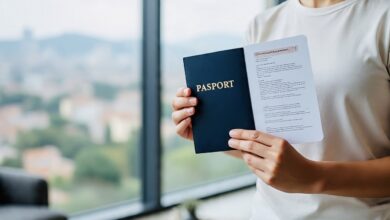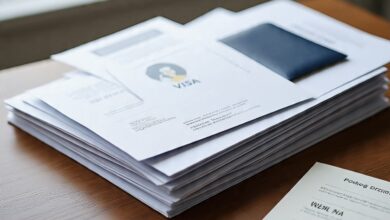Marriage is more than simply love and companionship; for many, it is the first step toward a new life in a new nation. Canada has a variety of immigration possibilities for people married to Canadian citizens or permanent residents, making it an appealing location for couples looking for a new beginning.
In this blog article, we will look at five options to obtain a Canadian visa through marriage and begin your road toward establishing a life together in the Great White North.
Types of Spouse Sponsorship Visas
There are two kinds of Spouse Sponsorship visas in Canada:
Spouse visa Canada Requirements
The spouse visa Canada requirements include
Documents required for Spouse Visa Canada
Obtaining the proper papers is a critical step in the application process. The list of often-needed papers is as follows:
How to Get a Canadian Visa Through Marriage
Step 1: Confirm Your Eligibility
Before beginning the application process, ensure that both the sponsor and the spouse satisfy the qualifying requirements.
Step 2: Get Ready the Necessary Documents to Submit
Gather any relevant personal, financial, and relationship records.
Applications can be submitted electronically through the IRCC website or by mail if accommodations are required.
Pay the applicable spousal sponsorship costs.
IRCC will assess the application and may require additional documentation. If necessary, the wife or husband may be compelled to attend an interview. If accepted, the sponsored spouse will be granted permanent resident status.
Once you get a decision from IRCC, your spouse’s visa application will be granted or denied. If it is accepted, congrats on your trip to Canada.
If you got a denial letter from IRCC, you must appeal your denied spouse visa application within 30 days of receiving it.
Outland Spousal Sponsorship Canada Step-by-Step
The Outland Spousal Sponsorship Canada step-by-step procedure is outlined below.
Step 1: Determine your eligibility and download the application package.
The Canadian sponsor and their spouse should first check to see if they both match the Outland Spousal Sponsorship eligibility standards. They can then obtain the application packet for this immigration route from the Government of Canada’s website.
Step 2: Gather the supporting documents.
The application package will detail the numerous documents that the Canadian sponsor and their spouse must include with their application. It is critical to begin gathering these documents as soon as possible because the procedure may take several weeks.
Step 3: Complete the Sponsorship Application.
The Canadian sponsor must complete the sponsorship application documents and pay the processing expenses. They should then send the completed paperwork and accompanying documentation to the relevant visa office in Canada.
Step 4: Wait for the sponsorship application decision.
IRCC will next certify whether the Canadian citizen or permanent resident is qualified to sponsor an Outland Spousal Sponsorship.
Step 5: Fill out the permanent residence application.
The spouse must complete their permanent resident application documents and pay the processing expenses. They should then send the completed paperwork and accompanying documentation to the relevant visa office in Canada.
Step 6: Finish the medical examinations and background checks.
IRCC will then request that the spouse undergo a medical test and background checks while their application is being processed.
IRCC will decide once the application has been processed. If accepted, the spouse will be granted a permanent residency visa, allowing them to go to Canada and reconnect with their partner.
Canada Family Visa Requirements
The requirements for a Canadian family visa are as follows:
Note: Canadian immigration officials may request further papers. The necessary supporting documentation relies on:
Canada Family Visa Application Process
Follow these steps for the Canada family visa:
The validity of a Canadian family visa is long. So the officials are severe about it. Check whether you are eligible. You should also determine your host’s eligibility. Both the host and the applicant must meet the conditions.
The application form may be obtained from the Immigration, Refugees, and Citizenship Canada website or the Canadian Embassy or consulate website in your country.
Take care to complete the correct application. As previously stated, there are several sorts of family visas. Complete the form based on your papers. Once finished, print, date, and sign it. You might have to fill out an online form. There is no need to print out an online form.
There is supporting documentation for a Canadian family visa. They will prove your eligibility for the visa. Follow the directions carefully and keep an eye out for derailments. Gather everything into a list. Please remember to give a copy of each document.
Applicants must submit the prerequisites to the authorities. You can either submit them online or in person. It depends on the type of visa. In-person submissions must be made to the Canadian embassy or consulate in your native country. Book an appointment with them.
Pay the cost for application processing. You may either pay the fees online or in cash. Conduct research and make the necessary arrangements.
It’s time to be patient. Wait for your visa application. Processing time varies depending on the factors. When your visa is accepted, officials will send it to you. If it is refused, they will tell you why.
Common Reasons for Spouse Visa Rejection:
Applying for a spouse visa in Canada does not ensure acceptance. Many applications are denied because of frequent errors. Understanding these factors might help you avoid delays and rejections.
One of the most prevalent causes of rejection is the failure to demonstrate a true relationship. Immigration officials search for:
Inconsistent or insufficient evidence (such as a lack of images, texts, or financial relationships).
There are significant cultural or age disparities that are not adequately explained.
There is no history of cohabitation or visits (for outland sponsorships).
Submitting incomplete or inaccurate forms results in automatic rejection.
Ensure that all necessary papers are included in the application.
Double-check the form’s correctness and compliance with the information supplied.
While there are no specific income requirements, sponsors must demonstrate their ability to financially support their spouse. If the sponsor is jobless or receiving social assistance (other than disability payments), the application may be denied.
If the sponsored spouse has a major criminal background, their visa may be refused.
A medical condition that puts the public’s health at danger may also result in rejection.
If the sponsored spouse has previously overstayed a visa or violated Canadian immigration regulations, their application may be reviewed further.
How to Strengthen Your Spouse Visa Application
1. Provide Strong Relationship Proof
Submit thorough documentation, such as travel records, video call logs, social media data, and letters from family and friends that prove the relationship.
Provide documentation of shared financial responsibilities, such as combined bank accounts, leases, or utility bills, as well as joint tax, insurance, and job benefits.
Use job letters, tax records, and bank statements to demonstrate financial stability.
If you are jobless, include other financial papers such as bank or investment assets, property ownership (in or out of Canada), or any extra sources of income (e.g., rental properties).
You might also attach documentation of job applications and possible employment offers to indicate your efforts to achieve financial security.
3. Prepare for an Interview (If Required)
Some applications may need an interview with IRCC personnel. Be open, confident, and ready to disclose your relationship past.
Getting a canada visa through marriage may look difficult due to the paperwork and processes, but with patience and careful planning, you have a high chance of success. Make sure you follow each step accordingly, and if your application is refused, do not give up; seek help and resubmit with a more detailed submission.





